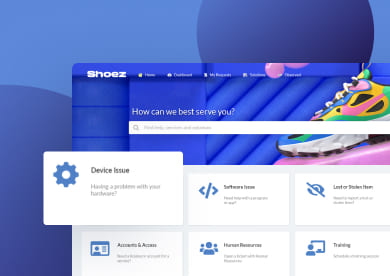In IT Service Management, Critical Incident Management coordinates the quick detection, declaration, and resolution of the most severe incidents (often SEV-1 or “major”). It relies on clear roles, a real-time bridge or war room, structured communication, and a blameless post-incident review to reduce impact and avoid future occurrences.
In this article, we’ll explore what CIM is, how it differs from regular Incident Management, and why classifying incidents by severity is crucial. We’ll also cover best practices and the tools you can use to keep your business running smoothly even in the face of disaster.

What is Critical Incident Management in IT?
In ITSM and ITIL 4, a Critical Incident refers to a high-impact service disruption that significantly affects business operations or a large number of users. It typically involves the loss of a critical business service, such as an outage in core systems (email, ERP, customer portal, etc.), leading to immediate and measurable business consequences, including halted operations, revenue loss, or regulatory exposure.
The defining attributes of a CIM are:
-
Business impact: The incident interrupts key business processes or affects services classified as mission-critical in the service catalog.
-
Urgency: Restoration is treated as the top operational priority, often invoking an accelerated or specialized response process (Major Incident Management).
-
Restoration goal: The primary objective is to restore service as quickly as possible, even if only through a temporary workaround, followed by a formal root cause analysis once stability is reestablished.
Is "critical incident" the same as "major incident" in IT?
In many organizations, the terms Critical Incident, SEV-1 (Severity 1), and Major Incident describe the same type of high-impact event, but they originate from different traditions.
Critical Incident tends to be a broader business term, often used in corporate risk or continuity management to describe the operational impact of such events.
Major Incident is the term formally defined in ITIL, while SEV-1 comes from engineering and DevOps practices, where incidents are categorized by technical severity levels.
When structuring an Incident Management Process, teams usually pick one terminology and apply it consistently across tools and communication.
Critical vs. “Standard” Incident Management
While both aim to restore normal service, Critical Incident Management operates under tighter timelines, broader visibility, and a higher degree of coordination. The difference lies in how teams prioritize, communicate, and measure their response.
| Critical Incident | Standard Incident | |
| Scope | Impacts core business services or a large user base; may trigger business continuity procedures. | Affects limited functionality, a single service, or a small group of users. |
| Urgency | Immediate; all necessary resources are mobilized until restoration. | Handled through routine prioritization based on SLA targets. |
| Escalation path | Direct involvement of senior technical and management staff. May invoke a specific protocol. | Managed by service desk and resolver groups within normal escalation rules. |
| Communication | Frequent status updates (e.g., every 15–30 minutes) to stakeholders and leadership until resolution. | Updates provided according to standard SLA communication intervals. |
| Metrics | Tracked separately with focus on Mean Time to Restore Service (MTRS) and business downtime impact. | Measured primarily through SLA compliance and Mean Time to Resolve (MTTR). |
Severity levels and priorities
In Incident Management, severity and priority are related but distinct concepts.
- Severity reflects the impact of an issue — how much business or technical damage it causes.
- Priority combines impact and urgency to determine how quickly the team should act.
For example, a high-severity issue (a full outage) may not always have the highest priority if it affects a non-production system. Conversely, a moderate-severity issue in a critical customer-facing application could still receive top priority due to its urgency.
What’s a SEV-1 incident?
A Severity 1 (Critical) Incident causes a complete outage or failure of critical systems or services, impacting all users or a significant portion of the business.
- Example triggers: ERP or email system unavailable, customer portal down.
- Actions: Immediate escalation to the highest level of IT and business management. Continuous communication with stakeholders and rapid response teams to resolve the issue.
- Example SLA targets:
- Response: Immediate.
- Update cadence: Every 15–30 min.
- Resolve: Within 4 hours or as per major incident process.
Severity 2 (High):
SEV-2 incidents significantly degrade the performance or availability of essential services, affecting a large group of users.
- Example triggers: Degraded performance on main service or key feature unavailable.
- Actions: Prioritized for rapid resolution. Involvement of senior IT Management and focused communication to affected users.
- Example SLA targets:
- Response: Within 30 min.
- Update cadence: Every 1–2 hours.
- Resolve: Within 8 hours.
Severity 3 (Moderate):
SEV-3 incidents cause partial service disruptions or performance issues, affecting multiple users but not critical systems.
- Example triggers: A single department can’t access a secondary tool.
- Actions: Handled with standard Incident Management processes but with increased monitoring and regular updates to stakeholders.
- Example SLA targets:
- Response: Within 2 hours.
- Update cadence: Every 4 hours.
- Resolve: Within 24 hours.
Severity 4 (Low):
SEV-4 incidents cause minor service disruptions or issues, with limited impact on business operations.
- Example triggers: UI glitch or intermittent issue without service interruption.
- Actions: Managed through standard processes with regular updates. Resolution may be deferred if higher-severity incidents occur.
- Example SLA targets:
- Response: Within 4 hours.
- Update cadence: Daily or on request.
- Resolve: Within 3 business days.
Severity 5 (Informational):
SEV-5 incidents have no immediate impact on services but require attention to prevent future issues.
- Example triggers: User question or routine log entry.
- Actions: Logged for future reference or preventive action. No immediate response required.
- Example SLA targets:
- Response: Within 1 business day
- Update cadence: As needed
- Resolve: Within 5 business days

How to design your severity matrix (practical steps)
-
List your key services and business functions. Identify which ones are mission-critical and define what “downtime” means for each.
-
Map impact levels. Define clear business and technical criteria for what constitutes severe, high, medium, and low impact.
-
Define urgency thresholds. Determine how quickly each type of issue should be addressed depending on service importance and time sensitivity.
-
Set response and communication targets. Establish who must be notified and how often, especially for SEV-1 and SEV-2 incidents.
-
Review and validate with stakeholders. Align your matrix with business owners, support teams, and management to ensure expectations are realistic and measurable.
-
Automate and monitor. Implement severity assignment and escalation rules in your ITSM tool, and review data regularly to confirm SLAs and priorities reflect actual business impact.
The Critical Incident Management process (step-by-step)
The fundamentals of Critical Incident Management stay the same across organizations, but how each step plays out depends on the context. In practice, there are two main scenarios:
-
Internal IT teams supporting business operations.
These teams manage corporate infrastructure, applications, and vendor systems (for example, ERP, HR, or communication tools). Their priority is restoring employee productivity and core business functions. Vendor coordination and internal incident communications usually play a bigger role than deep technical debugging. -
Service providers or software companies running customer-facing platforms.
Their incidents often involve production environments, infrastructure, and user-facing systems. The focus is on rapid technical mitigation, clear customer communication, and preventing reputational or contractual impact.
Despite these differences, both follow a similar sequence: detect the disruption, coordinate a rapid response, restore service, and review what happened to prevent recurrence.
Some organizations also rely on managed service providers (MSPs) to handle their IT operations. Their incident processes often combine aspects of both internal and customer-facing teams, since they must coordinate with client stakeholders while maintaining service continuity.
1- Detection and declaration
Incidents can originate from monitoring alerts, user reports, or third-party notifications. Once verified, the team evaluates impact and urgency to decide if it meets the criteria for a critical or major classification.
When declared, the Incident Commander notifies key roles, assigns ownership, and opens an incident bridge or chat channel for coordination.2- Triage and containment
The first goal is stabilization — to limit business or customer impact as fast as possible.
- Gather responders: Incident Commander, technical leads, communications lead, and vendor or partner contacts if applicable.
- Identify known workarounds or rollback options. For internal teams, that may mean enabling manual processes or switching to backup systems; for service providers, redirecting traffic or disabling faulty components.
- Keep communication tight and factual: what’s affected, what’s being done, and when the next update will come.
3- Resolution and recovery
Once containment holds, focus shifts to restoring full service.
- Apply the approved fix, configuration change, or vendor patch.
- Verify recovery: for internal IT, confirm with system owners and key users; for service providers, monitor production metrics and customer feedback.
- Record key timestamps and decisions in the incident log.
- Keep updates flowing until stability is confirmed.
4- Closure and post-incident review
With services restored, formally close the incident and convert lessons into action.
- Send a final update confirming resolution and restoration times.
- Schedule a Post-Incident Review (PIR) within a few days—ideally within 3 business days for SEV-1 incidents.
- Keep it blameless: focus on what slowed detection, communication, or escalation rather than who made the mistake.
- Capture both technical and procedural follow-ups, such as revising escalation paths, improving vendor SLAs, or tuning monitoring alerts.

Roles and responsibilities
Critical incident response requires clear accountability and coordinated action. A simple RACI (Responsible, Accountable, Consulted, Informed) framework helps define who does what, reducing confusion during high-pressure situations.
Incident Commander or Major Incident Manager
This role coordinates the overall response effort. The Incident Commander (or Major Incident Manager in ITIL terms) directs technical and communication activities, approves decisions that affect service restoration, and maintains situational awareness across teams.
- Scope: Full authority over incident response for SEV-1 or major incidents.
- Decisions: Prioritizes restoration paths, manages escalation, and decides when to declare or close a critical incident.
- Communications: Acts as the single point of contact for updates and ensures consistency across all channels.
Technical Leads and On-call SRE/SMEs
Technical Leads and on-call subject matter experts (SMEs) or site reliability engineers (SREs) handle diagnosis and recovery. They investigate the root cause, apply fixes or mitigations, and document key actions for the post-incident review.
- Focus: Technical containment and restoration.
- Inputs: Use monitoring data, runbooks, and system logs to guide decisions.
- Collaboration: Keep communication open with the Incident Commander and other technical teams to avoid redundant work.
Communications Lead and Stakeholder Manager
The Communications Lead manages internal and external updates, while a Stakeholder Manager ensures affected business units and executives receive consistent information.
- Responsibilities: Craft and publish updates on the status page, coordinate internal briefings, and maintain a predictable update cadence.
- Tone and clarity: Messages must describe the impact, current actions, and next update time without unnecessary jargon.
- Goal: Keep users informed and leadership confident in the response process, freeing technical teams to focus on resolution.
Communication during a critical incident
Clear, consistent communication is as important as the technical response. The goal is to reduce uncertainty for users and stakeholders while allowing responders to focus on restoration. Four principles guide effective communication:
- Communicate early. Acknowledge the issue as soon as it’s detected — silence erodes confidence faster than incomplete information.
- Communicate often. Maintain a predictable rhythm for updates; even “no change” messages reassure stakeholders that the situation is being managed.
- Be precise. Stick to verified facts, scope, and timelines. Avoid speculation or overly technical detail unless the audience requires it.
- Stay consistent. Use a single, reliable channel — such as a status page or incident hub — as the source of truth for all communications.
Incident bridge and war room basics
For SEV-1 or major incidents, an incident bridge (or virtual war room) brings together the key responders in real time. The bridge remains active until stabilization is confirmed.
-
When to open it: As soon as an incident meets critical impact criteria or multiple resolver groups are required.
-
Who joins: Incident Manager, service owner, key technical leads, communications manager, and any relevant vendors.
- Etiquette:
- Keep one person coordinating and documenting actions.
- Avoid side conversations.
- Summarize decisions clearly.
- Maintain focus on restoration rather than root cause analysis.
First update template and recurring updates
First update (acknowledgment):
We are aware of an issue affecting [service name]. Users may experience [brief impact description]. The team is investigating and working to restore normal service. Next update in [time interval].
Recurring updates:
Investigation continues. Root cause not yet identified / Mitigation applied. Current status: [impact summary]. Estimated time to next update: [interval].
Resolution notice:
Service [name] has been restored. The issue began at [time] and was resolved at [time]. A post-incident review will follow to confirm cause and preventive actions.
Metrics and SLOs that matter
Quantifying how well your team handles incidents helps validate response effectiveness and highlight improvement areas. The key is to measure not only speed but also consistency and recovery quality.
Two metrics anchor most performance reviews:
-
MTTA (Mean Time to Acknowledge): Average time between incident detection and the first acknowledgment by the response team. It reflects monitoring efficiency and alert responsiveness.
- MTTR (Mean Time to Restore/Resolve): Average time to return service to normal. Variants include:
- MTTD (Mean Time to Detect): How quickly an issue is identified.
- MTTI (Mean Time to Identify): How long it takes to confirm the root cause.
- MTTF (Mean Time to Fix): Duration of the actual remediation effort once the cause is known.
During Post-Incident Reviews (PIRs), teams should track:
- Timeline metrics (detection, acknowledgment, restoration).
- Escalation accuracy (whether the right severity and priority were assigned).
- Communication timeliness and accuracy.
- Business impact duration (actual vs. SLA target).
Metrics take on slightly different meanings depending on the type of IT operation:
- Internal IT teams focus on reducing downtime that affects employee productivity and internal systems.
- Service providers or SaaS platforms align their metrics with customer-facing SLAs, emphasizing transparency and user experience.
- Managed service providers (MSPs) bridge both views, reporting to clients while maintaining service continuity across multiple environments.
In closing
Effective incident classification, along with best practices and the right tools, can make all the difference in minimizing the impact of critical incidents.
InvGate Service Management is a powerful ITSM tool that supports Critical Incident Management by providing comprehensive workflow automation and advanced reporting capabilities. Its ITIL certification ensures it aligns with best practices (including Incident Management), making it an ideal choice for managing critical incidents.
Don’t forget that you can start exploring its capabilities and features right now with our 30-day free trial!














.jpg?upsize=true&upscale=true&width=780&height=205&name=ITIL%20Foundation%20Exam%20(2).jpg)
